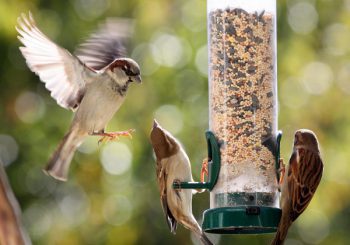By Jane Marsh
Guest Writer for Wake Up World
How often do you notice wildlife in your backyard? As new developments enter towns and rural areas, wildlife habitats are being destroyed, which has displaced animals like birds, deer and even bugs.
Some people’s yards have become a haven for wild creatures, and that’s because they take the time to make their yards natural and protected from outside sources. If you want your backyard to be like that, then here are 10 ways you can help wildlife in your backyard.
1. Feed the Birds — and Only the Birds
Many people love to put birdseed out to feed the birds at all times of the year. It’s a great way to help them stay full, especially in harsh weather conditions or when they need fuel to migrate. Choose natural foods like seeds and nuts. Try to avoid giving them any processed bread.
While it might be tempting to feed other wildlife, only stick with feeding the birds. Of course, that deer or raccoon may look helpless wandering into your yard, but if you provide for it, it will keep coming back and cannot learn how to survive on its own. Plus, not all humans are helpful when it comes to animals, and they might get ensnared in a trap rather than food.
2. Provide Fresh Water
Although you shouldn’t feed all animals, you can provide them with a fresh water source. In the winter, summer, spring or fall, wild animals need water to survive. For some, finding a freshwater source could be the difference between life and death.
There are a few ways to provide fresh water. Here are some examples:
- Creating a small pond
- Building a birdbath
- Making a fountain feature
These reliable sources of water are perfect for wildlife in your backyard.
3. Plant Flowers or a Garden
Flowers and blooming plants will attract wildlife and provide food for insects. Research native wildflower species for your region, and plant a small bed of flowers or plant them in pots. Besides providing food for insects, the flowers will look and smell beautiful in your yard.
If you would rather have vegetables growing than flowers, then you can plant a vegetable garden. It will provide insects with the same benefits. Plus, you’ll have fresh vegetables at the end of the growing season to enjoy, and you can put scraps in a compost pile, which provides a habitat for worms, spiders and frogs.
4. Skip the Pesticides
Pesticides and fertilizers filled with chemicals will steer wildlife away from your backyard. These are incredibly harmful to both the surrounding environment and animals. Your children and pets can also get sick from pesticides if you’re not careful.
Instead, use organic mulch or use companion planting as a substitute for pesticides and fertilizers. They are much more environmentally friendly, and they do an excellent job of keeping your yard healthy.
5. Keep Your Pets Inside
Whether you have dogs or cats, try to keep them inside as much as possible or keep an eye on them when you let them outside. Cats are especially a massive threat to wildlife like birds and mice. Pets have instincts that tell them to go after small things that move.
Keeping your pets indoors will also protect them. Wildlife larger than your pets could enter your yard as well, and they could harm your pets.
6. Set Up a Shelter for Wildlife
There are multiple different ways you can set up a shelter for the wildlife in your backyard. Here are a few examples of wildlife shelters:
- Bat house: Like insects, bats pollinate plants and disperse seeds. They also eat bugs, which keeps the insect population at bay. Give them a safe space to live with a bat house.
- Birdhouse: Many people may decorate their yards with birdhouses, which serve a purpose besides making their yard look nice. Birdhouses allow females to lay their eggs in a safe place.
- Brush pile: Instead of burning your brush, keep it in a small pile at the edge of your yard so small animals have a place of protection.
- Toad abode: Turned-over clay pots that are cracked and broken are the perfect toad abodes.
Each of these will help wildlife in some way by providing them with a safe shelter.
7. Mow a Little Less Lawn
Who wouldn’t love to mow a little bit less grass in the summer? Leave a small patch to grow wild during the summer. It creates a better habitat for wildlife because it’s more natural than trimmed grass.
In the patch, wildflowers will grow, bees and worms will burrow in the ground, and small animals may come to graze in the unkempt patch. You’ll create a small wildlife sanctuary right in your backyard.
8. Clean Up Litter
Anyone concerned about the environment’s health knows to put their trash and recyclables in the proper receptacles. Ensure you keep your backyard clear of any garbage or other items that could harm animals.
Additionally, pick up trash when you see it in your neighborhood. Small animals can get trapped in plastic bottles, bags and cans. Other predators could mistake trash for food. Do your part and encourage your neighbors to do the same.
9. Learn About the Wildlife in Your Backyard
Learning more about the wildlife in your backyard and your region can better equip you with tools to help them. If you have a population of honeybees or a particular bird, becoming knowledgeable about them will lead to you better caring for them.
You can learn about endangered species in your area, too. Many people are unaware of how many endangered species exist. Reach out to other community members so you can help protect them.
10. Keep Landscaping As Is
Finally, you can help wildlife in your backyard by keeping your landscaping as is. Significant changes to landscaping can uproot an entire population of wildlife. If you’re planning on making upgrades to your yard, consider the wildlife, too.
If you just moved to a new home, it might be tempting to change the landscaping. However, birds, bugs and other animals make their homes in trees and brush piles. If you drain puddles or swamps, you could be taking away a fresh water source. Sometimes, you have to change the landscaping — if that’s the case, do it carefully.
Take Action to Help Wildlife
With these tips, you can create a sanctuary for all kinds of creatures. You’ll notice more wildlife entering your yard, and you can sit back and enjoy them! Encourage your friends and neighbors to do the same for wildlife.
Recommended articles by Jane Marsh:
- 10 Tips for Living an Eco-Friendly Life With Your Pet
- 10 Physical and Mental Benefits of Houseplants
- How Switching to a Pescatarian Diet Benefits the Planet
- Should You Have Renewable Energy Installed in Your Home?
- 10 Ways to Increase Your Home’s Sustainability This Winter
- The Best Sustainable Resolutions for 2021
- How You Can Cut Carbon From Your Diet
- 10 Ways to Reduce Your Waste this Holiday Season
About the author:
 Jane is the founder and editor-in-chief of Environment.co where she shares practical tips on how to live a greener life.
Jane is the founder and editor-in-chief of Environment.co where she shares practical tips on how to live a greener life.

If you've ever found value in our articles, we'd greatly appreciate your support by purchasing Mindful Meditation Techniques for Kids - A Practical Guide for Adults to Empower Kids with the Gift of Inner Peace and Resilience for Life.
In the spirit of mindfulness, we encourage you to choose the paperback version. Delve into its pages away from screen glare and notifications, allowing yourself to fully immerse in the transformative practices within. The physical book enriches the learning process and serves as a tangible commitment to mindfulness, easily shared among family and friends.
Over the past few years, Wake Up World has faced significant online censorship, impacting our financial ability to stay online. Instead of soliciting donations, we're exploring win-win solutions with our readers to remain financially viable. Moving into book publishing, we hope to secure ongoing funds to continue our mission. With over 8,500 articles published in the past 13 years, we are committed to keeping our content free and accessible to everyone, without resorting to a paywall.







